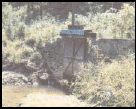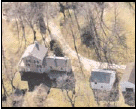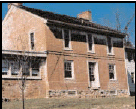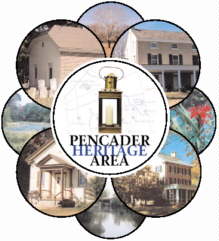 The winding Christina River influenced the lives of the people who settled along its banks in this northwestern corner of Delaware. Nearly twenty-nine miles long from the Delaware River to the state line, seven miles pass through Pencader Hundred. The river meanders and winds its way in so many directions that the Pencader section actually covers only a little over four and a half miles as the crow flies. Joseph Plumb Martin, a Revolutionary War soldier, wrote in his diary that his ship sailed four miles up the Christina in order to gain forty rods!
The winding Christina River influenced the lives of the people who settled along its banks in this northwestern corner of Delaware. Nearly twenty-nine miles long from the Delaware River to the state line, seven miles pass through Pencader Hundred. The river meanders and winds its way in so many directions that the Pencader section actually covers only a little over four and a half miles as the crow flies. Joseph Plumb Martin, a Revolutionary War soldier, wrote in his diary that his ship sailed four miles up the Christina in order to gain forty rods!
During the era of waterpower the river volume was adequate to keep several gristmills in operation grinding local harvests of grain. Equally important were the sawmills, which turned the forests into much needed lumber for buildings and ships. So prolific were the mills that by 1883 timber was already scarce in Pencader. Some of the abandoned dam sites are still visible with weed-choked headraces and tailraces that fill with water after a heavy rain.
The early growth of Pencader depended upon the close interaction between mill operators and farmers, each occupation dependant on the other. Running the mills that turned the harvests of grain and corn into flour and meal should have been a profitable occupation but the old deeds tell a different story. The mill built on Five Mile Run by Alexander Porter was willed to his two sons in 1769. From that time, until Adam Dayett purchased it in 1853, the business changed hands ten times with some sales being only a year apart. The Porter mill fared better than most in that a sheriff's sale was not included in the many transfers of title.
 Two of the three mills built by the Cooch family are still standing near the Christina River. The British burned the first, built between 1702 and 1707, after the battle of Cooch's Bridge. The replacement dates to 1792, and it in turn was replaced and later enlarged during the years 1822 to 1836. The mills are unique in the length of time they remained in one family. When ownership of the latest mill was transferred to John W. Dayett in 1893, the Coochs had owned the business for three generations. Now called the Dayett Mill, the historic brick building is undergoing renovations and will be a major attraction in the Pencader Historic Area, illustrating to visitors of all ages how grain was turned into flour without a single spark of electricity. Fisher's Mill, about a mile upstream also featured in the Revolutionary War but did not suffer the same fate as Cooch's Mill. In 1768, Andrew Fisher purchased land at a sheriff's sale that had been part of a largely unsuccessful business venture between eight partners in 1726. Originally called Abitinton Forge, later changed to Abbington Iron Works, it was one of the many failed attempts to process the iron ore in the Iron Hill area. Fisher erected a grist mill and a saw mill on the land, the former turning out twenty-five barrels of flour a day. After the battle at Cooch's Bridge, while Lord Cornwallis was occupying Mr. Cooch's house (and according to the Cooch family his horse was occupying the parlor) some of the British soldiers, probably under Colonel von Donop, stayed in the mansion house at Fisher's Mill. Instead of burning the mill, he used it to furnish much needed flour to his troops. The mill was lost, in 1883, in a fire, and never rebuilt. Fire was a constant danger in a wooden building full of fine flour dust; one spark could easily ignite the particle charged air and it frequently did.
Two of the three mills built by the Cooch family are still standing near the Christina River. The British burned the first, built between 1702 and 1707, after the battle of Cooch's Bridge. The replacement dates to 1792, and it in turn was replaced and later enlarged during the years 1822 to 1836. The mills are unique in the length of time they remained in one family. When ownership of the latest mill was transferred to John W. Dayett in 1893, the Coochs had owned the business for three generations. Now called the Dayett Mill, the historic brick building is undergoing renovations and will be a major attraction in the Pencader Historic Area, illustrating to visitors of all ages how grain was turned into flour without a single spark of electricity. Fisher's Mill, about a mile upstream also featured in the Revolutionary War but did not suffer the same fate as Cooch's Mill. In 1768, Andrew Fisher purchased land at a sheriff's sale that had been part of a largely unsuccessful business venture between eight partners in 1726. Originally called Abitinton Forge, later changed to Abbington Iron Works, it was one of the many failed attempts to process the iron ore in the Iron Hill area. Fisher erected a grist mill and a saw mill on the land, the former turning out twenty-five barrels of flour a day. After the battle at Cooch's Bridge, while Lord Cornwallis was occupying Mr. Cooch's house (and according to the Cooch family his horse was occupying the parlor) some of the British soldiers, probably under Colonel von Donop, stayed in the mansion house at Fisher's Mill. Instead of burning the mill, he used it to furnish much needed flour to his troops. The mill was lost, in 1883, in a fire, and never rebuilt. Fire was a constant danger in a wooden building full of fine flour dust; one spark could easily ignite the particle charged air and it frequently did.
 The Fisher mansion house survived both the British and the fires and is one of Pencader's historic sites whose deeds furnish the researcher with a great deal of information on life in 1814. At that time the house and land were being divided between Andrew Fisher's two sons, John and Samuel, with Mrs. Fisher retaining what was then called the widow's thirds. In order to 'share and share alike' a line was drawn right through the front entry hall to the garden fence. In addition to sixty acres, including fourteen acres of woodland, she was allotted one room on the first floor, one room on the second floor, the cellar under these rooms and the garrett above. She was allowed to use water from the well and smoke her meat in the smokehouse and was given the use of the stable between the house and barn ' as well as that part of the Barn West of the thrashing floor as far back as the new end but none other part.'
The Fisher mansion house survived both the British and the fires and is one of Pencader's historic sites whose deeds furnish the researcher with a great deal of information on life in 1814. At that time the house and land were being divided between Andrew Fisher's two sons, John and Samuel, with Mrs. Fisher retaining what was then called the widow's thirds. In order to 'share and share alike' a line was drawn right through the front entry hall to the garden fence. In addition to sixty acres, including fourteen acres of woodland, she was allotted one room on the first floor, one room on the second floor, the cellar under these rooms and the garrett above. She was allowed to use water from the well and smoke her meat in the smokehouse and was given the use of the stable between the house and barn ' as well as that part of the Barn West of the thrashing floor as far back as the new end but none other part.'
|
